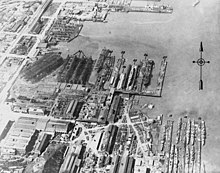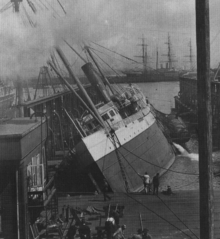
Newport News Shipbuilding (NNS), a division of Huntington Ingalls Industries, is the largest industrial employer in Virginia, and sole designer, builder, and refueler of aircraft carriers and one of two providers of submarines for the United States Navy. Founded as the Chesapeake Dry Dock and Construction Co. in 1886, Newport News Shipbuilding has built more than 800 ships, including both naval and commercial ships. Located in the city of Newport News, its facilities span more than 550 acres (2.2 km2), strategically positioned in one of the great harbors of the East Coast.

Ingalls Shipbuilding is a shipyard located in Pascagoula, Mississippi, United States, originally established in 1938, and now part of HII. It is a leading producer of ships for the United States Navy, and at 12,500 employees, the second largest private employer in Mississippi.

Vigor Shipyards is the current entity operating the former Todd Shipyards after its acquisition in 2011. Todd Shipyards was founded in 1916, which owned and operated shipyards on the West Coast of the United States, East Coast of the United States and the Gulf. Todd Shipyards were a major part of the Emergency Shipbuilding Program for World War II.
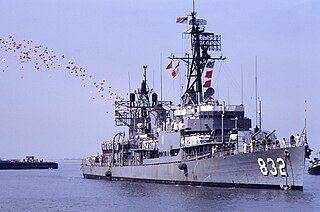
The Gearing class was a series of 98 destroyers built for the U.S. Navy during and shortly after World War II. The Gearing design was a minor modification of the Allen M. Sumner class, whereby the hull was lengthened by 14 ft (4.3 m) at amidships, which resulted in more fuel storage space and increased the operating range.

Bethlehem Steel Corporation Shipbuilding Division was created in 1905 when the Bethlehem Steel Corporation of Bethlehem, Pennsylvania, acquired the San Francisco shipyard Union Iron Works. In 1917 it was incorporated as Bethlehem Shipbuilding Corporation, Limited.

Fore River Shipyard was a shipyard owned by General Dynamics Corporation located on Weymouth Fore River in Braintree and Quincy, Massachusetts. It began operations in 1883 in Braintree, and moved to its final location on Quincy Point in 1901. In 1913, it was purchased by Bethlehem Steel, and later transferred to Bethlehem Shipbuilding Corporation. It was sold to General Dynamics in 1963, and closed in 1986. During its operation, yardworkers constructed hundreds of ships, for both military and civilian clients.

The Benson class was a class of destroyers of the U.S. Navy built 1939–1943. The thirty 1,620-ton Benson-class destroyers were built in two groups. The first six were authorized in fiscal year 1938 (FY38) and laid down at Bethlehem Steel, Quincy, Massachusetts, and three naval shipyards. The remaining 24 "repeat Bensons" were authorized in 1940–42 and built at four Bethlehem Steel yards. They were laid down after the first group was commissioned. These plus the "repeat Livermores" were also known at the time as the Bristol class. During World War II the Bensons were usually combined with the Livermores as the Benson-Livermore class; this persisted in references until at least the 1960s. In some references both classes are combined and called the Benson class. The Benson- and Gleaves-class destroyers were the backbone of the pre-war Neutrality Patrols and brought the action to the enemy by participating in every major campaign of the war.

The first USS Farenholt (DD-332) was a Clemson-class destroyer in the United States Navy following World War I. She was named for Oscar Farenholt.

USS Corry (DD-334) was a United States Navy Clemson-class destroyer launched and commissioned in 1921.
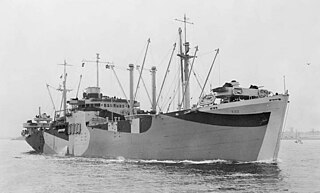
Type C1 was a designation for cargo ships built for the United States Maritime Commission before and during World War II. Total production was 493 ships built from 1940 to 1945. The first C1 types were the smallest of the three original Maritime Commission designs, meant for shorter routes where high speed and capacity were less important. Only a handful were delivered prior to Pearl Harbor. But many C1-A and C1-B ships were already in the works and were delivered during 1942. Many were converted to military purposes including troop transports during the war.
The Consolidated Steel Corporation was an American steel and shipbuilding business. Consolidated built ships during World War II in two main locations: Wilmington, California and Orange, Texas. It was created in 1929 by the merger of Llewellyn Iron Works, Baker Iron Works and Union Iron Works, all of Los Angeles. The company entered the shipbuilding business in 1939. In 1948, now a producer of large-diameter pipelines, Consolidated Steel was renamed Consolidated Western Steel and acquired by U.S. Steel and operated as a wholly-owned subsidiary. The San Diego-based Consolidated Aircraft Corp. is not related and neither is the Union Iron Works of San Francisco.

The Federal Shipbuilding and Drydock Company was a United States shipyard in New Jersey active from 1917 to 1948. It was founded during World War I to build ships for the United States Shipping Board. Unlike many shipyards, it remained active during the shipbuilding slump of the 1920s and early 1930s that followed the World War I boom years. During World War II, it built merchant ships as part of the U.S. Government's Emergency Shipbuilding program, at the same time producing more destroyers for the United States Navy than any yard other than the Bath Iron Works. Operated by a subsidiary of the United States Steel Corporation, the shipyard was located at Kearny Point where the mouth of the Hackensack River meets Newark Bay in the Port of New York and New Jersey.

USS Mizar (AF-12) was the United Fruit Company fruit, mail and passenger liner Quirigua that served as a United States Navy Mizar-class stores ship in World War II.

The Seattle-Tacoma Shipbuilding Corporation was an American corporation which built escort carriers, destroyers, cargo ships and auxiliaries for the United States Navy and merchant marine during World War II in two yards in Puget Sound, Washington. It was the largest producer of destroyers (45) on the West Coast and the largest producer of escort carriers of various classes (56) of any United States yard active during World War II.

Liberty Fleet Day was first observed on 27 September 1941, the day that 14 merchant ships were launched in shipyards across the United States under the Emergency Shipbuilding program. Among the ships launched was the first Liberty ship, SS Patrick Henry. Some of the merchant ships were subsequently converted to other purposes, including as troop transports and a Royal Navy aircraft carrier. In addition to the merchant ships launched, the US Navy launched two destroyers at the Boston Navy Yard.
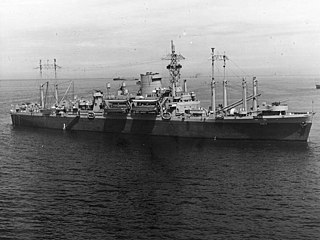
SS Panama was laid down 25 October 1937 as hull number 1467, launched on 24 September 1938 and completed 22 April 1939 at Bethlehem Shipbuilding Corporation in Quincy Massachusetts. The ship was given the official number 238343 and was owned and operated by the Panama Railroad Company. The ship was built for 202 single class passengers with a crew of 124. Panama was sister ship to USS Ancon and SS Cristobal.
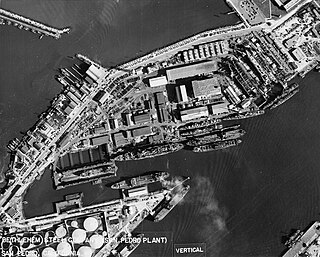
Bethlehem Shipbuilding San Pedro was a major shipbuilding company on Terminal Island in San Pedro, California owned by Bethlehem Shipbuilding Corporation. To support the World War 2 demand for ships Bethlehem Shipbuilding San Pedro built: US Navy Destroyers and after the war tugboats. The yard became involved in World War II production in the early shipbuilding expansions initiated by the Two-Ocean Navy Act of July 1940. At its peak during the war about 6,000 worked at the yard, Bethlehem Shipbuilding San Pedro shipyard was opened in 1918 as Southwestern Shipbuilding by Western Pipe & Steel. Western Pipe & Steel sold the shipyard to Bethlehem Shipbuilding Corporation in 1925. Shipbuilding ended after World War 2 in 1946. In 1983 the shipyard was sold to Southwest Marine. In 1997 Southwest Marine operated four shipyards, which they sold to The Carlyle Group. Carlyle Group renamed the shipyard US Marine Repair. In 2002 US Marine Repair sold all six of its yards to United Defense Industries. In 2005 it was sold to BAE Systems but the yard was not used and the yard is now part of the Port of Los Angeles. The shipyard was located at 1047 South Seaside Ave, San Pedro.

Potrero Point is an area in San Francisco, California, east of San Francisco's Potrero Hill neighborhood. Potrero Point was an early San Francisco industrial area. The Point started as small natural land feature that extends into Mission Bay of San Francisco Bay. The Point was enlarged by blasted and cuts on the nearby cliffs. The cut material was removed and used to fill two square miles into the San Francisco bay, making hundreds of acres of flat land. The first factories opened at Potrero Point in the 1860s. Early factories were powder magazine plant, the Pacific Rolling Mill Company and small shipyards. The large Union Iron Works and its shipyards were built at the site, stated in 1849 by Peter Donahue. To power the factories and neighborhood coal and gas-powered electricity works were built, later the site became Pacific Gas and Electric Company (PG&E).

Bethlehem Staten Island also called Bethlehem Mariners Harbor was a large shipyard in Mariners Harbor, Staten Island, New York. The shipyard started building ships for World War II in January 1941 under the Emergency Shipbuilding Program and as the result of the Two-Ocean Navy Act of July 1940. The shipyard was part of the Bethlehem Shipbuilding Corporation which built ships for the United States Navy, and the United States Maritime Commission. Bethlehem Steel purchased the shipyard in June 1938 from United Shipyards. Bethlehem Shipbuilding Corporation closed the shipyard in 1959. The propeller factory and foundry continued operation for 10 more years at the site. Since 1980 the site is the May Ship Repair Contracting Corporation next to Shooters Island at the southern end of Newark Bay, off the North Shore.

Naval Base San Pedro and San Pedro Submarine Base were United States Navy bases at the Port of San Pedro, California officially founded in 1919. While commissioned in 1919, the Navy started operating out of the port in 1910, by renting dock space at the City of San Pedro's Dock No. 1 in 1914. The Navy had vessels stationed at the port starting in 1913. The San Pedro Submarine Base closed in 1923, with the end of World War I. Naval Base San Pedro became part of Naval Operating Base Terminal Island on 25 September 1941, which closed in 1947.
